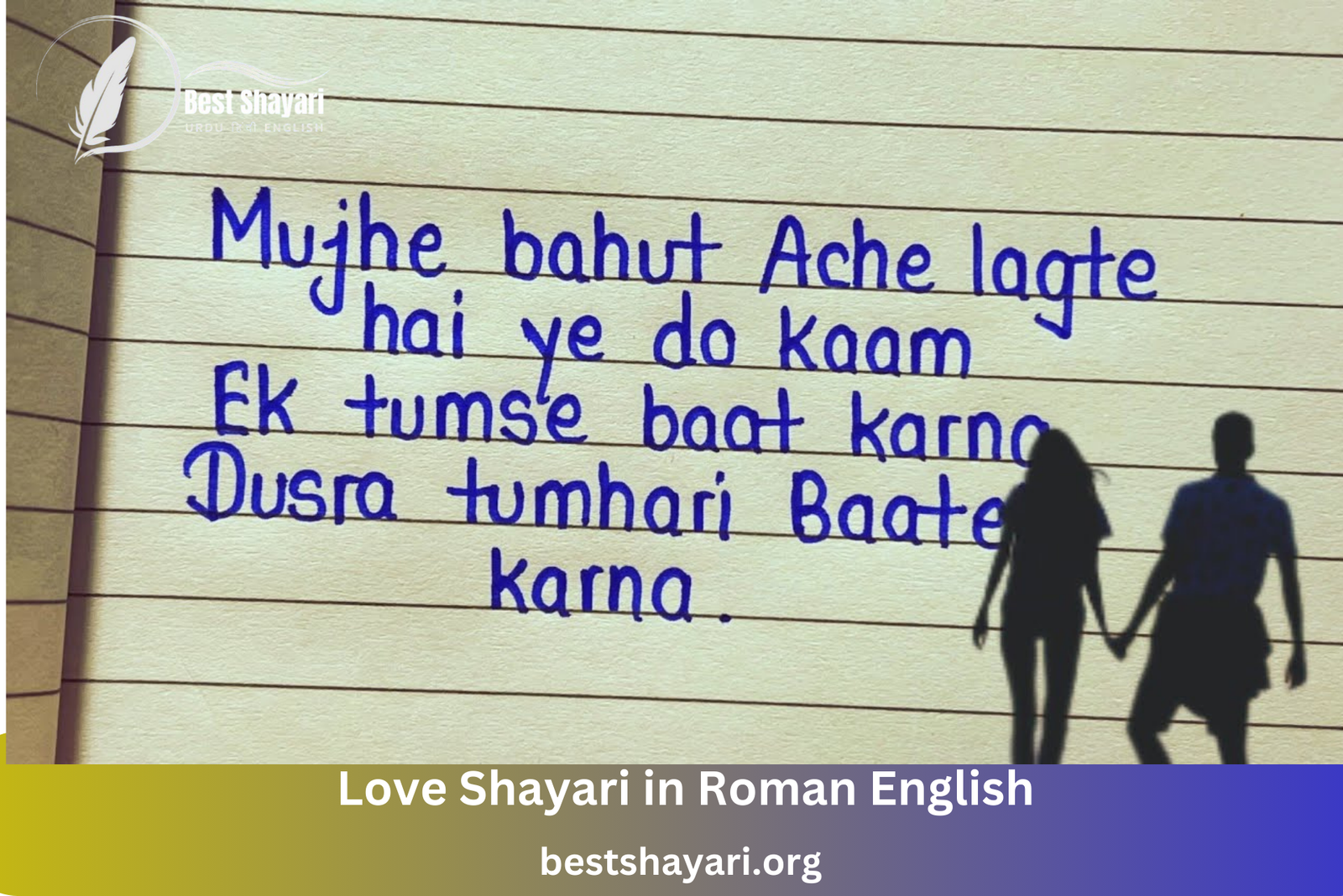Shayari is a famous form of poetry from the Indian subcontinent that is known for its melodiousness and profundity of emotions. It has contributed greatly to South Asian literature and culture, traditionally being written in Urdu. Shayari ranges from love lyrics to philosophical thoughts, as well as melancholy and humorous ones. Its most important thing is its ability to stir up deep feelings through concise verses.
Importance of Shayari in Love
In terms of love, Shayari could be considered as an artistic supplement to the spoken word that may fail when it comes to expressing some emotions. In romantic relationships, this form plays a significant role since it adds a more poetic tone to words of affectionate language or yearning across cultures. In south Asia societies, which interact with literature, music and day-to-day life; shayari has managed to become an integral part of their lives.
Understanding Love Shayari

What is Love Shayari?
Shayari generally comprises mostly poems consisting couplets or verses in which metaphors are often used together with similes and other expressive devices. The word “shair” (poet) originates from Persian language and hence other cultural borrowings over time have given birth to what we now call shayaris today. It usually follows certain rhythmic patterns and frequently delivers messages about love and beauty alongside human experiences.
Evolution of Love Shayari
Shayaris evolved from their Persian origins by adopting many things from Arabic as well as local languages. Early forms were strongly influenced by Persian poets but later enriched by different vernaculars particularly Urdu which dominates them until now. Modern Ghazals demonstrate modern themes/styles thereby exhibiting both traditional/invented principles into verse composition.
Shayari in Different Languages
Although typically it has been in Urdu, shayaris have accommodated several other languages such as roman English texts too. In addition, Roman English Shayaris combine both traditional poetic forms and contemporary linguistic practices, making them accessible to wider audience who do not understand the Urdu script.
Love Shayari
Defining Love Shayari
Love shayari is a subset of shayaris that focuses largely on romantic issues. It is seen as containing depths of emotions and being able to articulate complicated feelings around love, longing, and desire. They often communicate at two levels—personal and universal through symbolic expressions in the form of figurative language.
Popular Forms of Love Shayari
Ghazals for instance consist of rhyming couplets which are highly emotional while Dohe are short rhythmic verses. Free verse offers a more flexible structure thus it allows individuals to express their own unique feelings associated with relationships.
Characteristics of Love Shayari
Love shayaries’ emotional strength lies in their ability to condense love into few words. It makes use of strong imagery, deep feeling as well as flow however this leads in lasting impressions in minds or hearts.
Love Shayari in Roman English
Why Roman English?
Roman English Shayaris are specifically designed for a modern reader who prefers using the Roman alphabet when reading or writing. Adjustment enables shayaris reach out larger group since not all people know Urdu script but still remains very poetic as an art form.
Examples of Love Shayari in Roman English
Here are some examples of Love Shayari in Roman English:
- “Teri aankhon ki chamak se, meri duniya roshan hai, Tere bina yeh zindagi, ek khushbuon se faasla hai.”
- “Dil se jo baat nikalti hai, wo asar rakhti hai, Aasman bhi isay, aasmaan pe likhti hai.”
Write 50 lines on Love Shayari in Roman English;
- Teri aankhon ki chamak se roshni milti hai,
Mere dil ko tere pyar ki kashti milti hai.
- Tere bina adhoora hai mera har sapna,
Tere sath khilte hain mere armaan apna.
- Tere ishq mein dooba rehta hoon har pal,
Tu meri zindagi ka hai sabse khoobsurat kal.
- Tere bina zindagi bekaar lagti hai,
Tere saath har shaam gulzar lagti hai.
- Tere pyaar mein humne khud ko khona seekha,
Tere bina jeena kya hai, ye hona seekha.
- Teri muskurahat mein hai jadoo sa kuch,
Tere bina dil hai udaas, soona kuch.
- Tere saath rehna meri khwahish hai purani,
Teri yaadon mein khilti hai meri jawani.
- Teri baahon mein milta hai sukoon mujhe,
Tere bina sab kuch lagta hai bekar mujhe.
- Tere saath har raasta lagta hai asaan,
Tere bina mushkil hai jeena ka har imtihan.
- Tere pyar ki raunak se sajti hai meri duniya,
Tere bina zindagi adhoori hai, tu meri duniya.
- Teri awaaz sunke hi milti hai chain mujhe,
Tere bina jeene ka gham milta hai mujhe.
- Tere saath har din ek naya sapna hai,
Tere bina zindagi sirf ek sapna hai.
- Tere pyaar mein khoya rehta hoon har waqt,
Tere bina jeena lagta hai sirf ek waqt.
- Tere bina duniya lagti hai ajeeb,
Tere saath har pal lagta hai anokha jeeb.
- Tere pyar ki mahak se hai zindagi gulzar,
Tere bina udasi hai, bas milta hai andhera ghubar.
- Teri aankhon mein hai jadoo sa kuch,
Tere bina zindagi hai adhoori kuch.
- Tere saath jeene ka har pal pyara hai,
Tere bina jeene ka bas ek bahaana hai.
- Tere pyar mein humne sab kuch bhula diya,
Tere bina dil ko udaasi se bhar diya.
- Tere bina jeena lagta hai mushkil,
Tere saath har lamha lagta hai asaan silsila.
- Tere pyar mein hai sukoon sa kuch,
Tere bina jeena hai bekaar kuch.
- Tere saath har raat rangin hai,
Tere bina jeene ka sapna rangin hai.
- Tere bina dil udas rehta hai,
Tere saath har pal meetha rehta hai.
- Tere pyar mein hai khushi ka jadoo,
Tere bina zindagi hai bekaar ka jadoo.
- Tere saath har pal hai khushnuma,
Tere bina jeena lagta hai bewaja.
- Tere bina jeene ka gham nahi,
Tere saath jeene ka alam hai kuch nahi.
- Tere pyar mein hai sukoon sa kuch,
Tere bina jeena lagta hai bekaar sa kuch.
- Teri muskurahat se hai roshni milti,
Tere bina zindagi lagti hai andheri.
- Tere saath har pal lagta hai anokha,
Tere bina jeena hai bas ek dhokha.
- Tere pyar mein humne paayi hai khushiyan,
Tere bina jeene ka bas ek bahaana hai.
- Tere bina zindagi hai bas ek sapna,
Tere saath har pal hai khushnuma apna.
- Tere pyar ki roshni se roshan hai duniya,
Tere bina jeena hai bas ek andhera ghubar.
- Tere saath har pal lagta hai meetha,
Tere bina jeene ka bas ek bahaana beeta.
- Tere bina zindagi hai bas ek dhokha,
Tere saath har pal hai khushnuma rasta.
- Tere pyar mein humne khud ko paaya,
Tere bina jeene ka bas ek bahaana bhaya.
- Tere bina jeena lagta hai bekaar,
Tere saath har pal hai khushnuma pyar.
- Tere pyar mein hai khushi ka jadoo,
Tere bina zindagi hai andhera sa kuch naadoo.
- Teri muskurahat se hai roshni milti,
Tere bina zindagi lagti hai andheri milti.
- Tere saath har raat rangin hai,
Tere bina jeene ka sapna rangin hai.
- Tere bina dil udas rehta hai,
Tere saath har pal meetha rehta hai.
- Tere pyar mein hai khushi ka jadoo,
Tere bina zindagi hai bekaar ka jadoo.
- Tere saath har pal hai khushnuma,
Tere bina jeena lagta hai bewaja.
- Tere bina jeene ka gham nahi,
Tere saath jeene ka alam hai kuch nahi.
- Tere pyar mein hai sukoon sa kuch,
Tere bina jeena lagta hai bekaar sa kuch.
- Teri muskurahat se hai roshni milti,
Tere bina zindagi lagti hai andheri milti.
- Tere saath har pal lagta hai anokha,
Tere bina jeena hai bas ek dhokha.
- Tere pyar mein humne paayi hai khushiyan,
Tere bina jeene ka bas ek bahaana hai.
- Tere bina zindagi hai bas ek sapna,
Tere saath har pal hai khushnuma apna.
- Tere pyar ki roshni se roshan hai duniya,
Tere bina jeena hai bas ek andhera ghubar.
- Tere saath har pal lagta hai meetha,
Tere bina jeene ka bas ek bahaana beeta.
- Tere bina zindagi hai bas ek dhokha,
Tere saath har pal hai khushnuma rasta.
I hope you like these!
Translating Love Shayari from Urdu to Roman English
Shayari translation is more than simply converting words from one script to another. It necessitates a subtle grasp of the original emotional and cultural context for maintaining the poem’s essence. This can be accomplished by retaining rhythm, picking out equivalent expressions, and ensuring that the Shayari retains its emotional impact.
Crafting Your Own Love Shayari
Tips for Writing Shayari
The writing of Shayari entails tapping into one’s emotional experiences and expressing them via poetic language. Key considerations include understanding the emotions you want to communicate, enriching verses through metaphors and similes as well as focusing on rhythmic and lyrical qualities.
Structure and Style
While modern adaptations might vary, shayaris often take specific rhythmic patterns. Understanding different structures such as couplets or free verse will help you choose a style that best suits your emotional expression.
Common Mistakes to Avoid
Avoid clichés and overused expressions that may dilute the originality of your Shayari. Be genuine; let your verses truly reflect how you feel and if standard poetic forms do not align with your personal voice do not force yourself into them.
Love Shayari in Modern Context
Social Media and Shayari
Poets can reach out to global audiences through social media platforms where they share their crafted pieces such as shayaris. Furthermore, influencers have popularized Love Shayari even further due to viral content spreading which has made it become part-and-parcel of online cultures.
Shayari in Popular Culture
Shayari has penetrated different popular culture outlets including movies and music. Shayari is frequently used by public figures and celebrities in their expressions, furthering its inclusion in modern society.
The Future of Shayari
The future of shayari will likely be characterized by continued innovation with new forms and styles emerging as the genre evolves. The global influences and digital platforms will play a significant role in defining what the future landscape of Shayari looks like.
FAQs
What is the best way to start writing Shayari?
Start by looking into your emotions and experiences. Writing from the heart using different styles and structures until you find what resonates with you.
How can I translate Shayari while keeping its charm?
Stay within the emotional territory that the original Shayari covers in it’s poetry expression but use equivalent expressions, retain rhythm, tone from the original work.
Where can I find more examples of Love Shayari in Roman English?
Examples of this type are available on social media platforms, poetry websites, or compilations of modern shayaris in Roman English.
Conclusion
Summary of Key Points
Love Shayari in Roman English combines traditional poetic forms with contemporary linguistic practices making it understandable yet appealing to a wider audience. It conveys deep romantic feelings but also adapts to current cultural contexts.
Encouragement for Further Exploration
Deepen your understanding about this poetic tradition through exploring various forms and styles of shayari. For example, try composing your own verse or participate actively online among other members of shayaris vibrant community.
Call to Action
If you want to know more about Shayari both in Urdu and Roman English, then join online forums, attend literary events or read modern poetry collections to get a broader understanding of the same and improve your skills.

